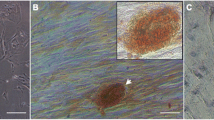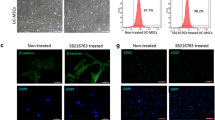Abstract
The aim of the study was to isolate and characterize a population of neuronal progenitors in the human umbilical cord blood (HUCB) mononuclear cell (MNC) fraction, for in vitro manipulation towards neuronal differentiation. Selection of the HUCB neuronal progenitors (HUCBNPs) was based on the neuronal prerequisite for adherence to collagen. Populations of collagen-adherent, nestin-positive (94.8 ± 2.9%) progenitors expressing α1/2 integrin receptors, as revealed by Western blot and adhesion assay using selective antagonists, were isolated and survived for more than 14 days. In vitro differentiation of the HUCBNPs was achieved by treatment with 10% human SH-SY5Y neuroblastoma cell-conditioning media (CM) supplemented with 10 ng/ml nerve growth factor (NGF). Some 83 ± 8.2% of the surviving progenitors acquired a neuronal-like morphology, expressed by cellular outgrowths of different lengths. About 35 ± 6% of the HUCBNPs had long outgrowths with a length/cell diameter ratio greater than 2, typical of developing neurons. The majority of these progenitors, analyzed by immunocytochemistry and/or RT-PCR, expressed common neuronal markers such as microtubule-associated protein 2 (MAP-2; 98.5 ± 2%), neurotrophin receptor (TrkA; 98.5 ± 0.06%), neurofillament-160 (NF-160; 94.2 ± 1%), beta-tubulin III (89.8 ± 4.2%) and neuron specific enolase (NSE). Combined CM and NGF treatment induced constitutive activation of the mitogen-activated protein kinases ERK2 (36-fold vs control), p38α (nine-fold vs control) and p38beta (23-fold vs control), most likely related to survival and/or differentiation. The results point to operationally defined conditions for activating neuronal differentiation of HUCBNPs ex vivo and emphasize the crucial role of neuronal CM and NGF in this process.





Similar content being viewed by others
References
Bracci-Laudiero, L., Celestino, D., Starace, G., Antonelli, A., Lambiase, A., Procoli, A., et al. (2003). CD34-positive cells in human umbilical cord blood express nerve growth factor and its specific receptor TrkA. Journal of Neuroimmunology, 136, 130–139.
Bradshaw, A. D., McNagny, K. M., Gervin, D. B., Cann, G. M., Graf, T., & Clegg, D. O. (1995). Integrin alpha 2 beta 1 mediates interactions between developing embryonic retinal cells and collagen. Development, 121, 3593–3602.
Buzanska, L., Machaj, E. K., Zablocka, B., Pojda, Z., & Domanska-Janik, K. (2002). Human cord blood-derived cells attain neuronal and glial features in vitro. Journal of Cell Science, 115, 2131–2138.
Campos, L. S. (2005). Beta1 integrins and neural stem cells: Making sense of the extracellular environment. BioEssays, 27, 698–707.
Carlson, K., & Ehrich, M. (2000). Human neuroblastoma cell viability and growth are affected by altered culture conditions. In Vitro & Molecular Toxicology, 13, 249–262.
Chang, J. C., Brewer, G. J., & Wheeler, B. C. (2003). A modified microstamping technique enhances polylysine transfer and neuronal cell patterning. Biomaterials, 24, 2863–2870.
Chao, M., Casaccia-Bonnefil, P., Carter, B., Chittka, A., Kong, H., & Yoon, S. O. (1998). Neurotrophin receptors: Mediators of life and death. Brain Research Brain Research Reviews, 26, 295–301.
Chen, N., Hudson, J. E., Walczak, P., Misiuta, I., Garbuzova-Davis, S., Jiang, L., et al. (2005). Human umbilical cord blood progenitors: The potential of these hematopoietic cells to become neural. Stem Cells, 23, 1560–1570.
Clegg, D. O. (2000). Novel roles for integrins in the nervous system. Molecular Cell Biology Research Communication, 3, 1–7.
Cohen, Y., & Nagler, A. (2004). Umbilical cord blood transplantation-how, when and for whom? Blood Review, 18, 167–179.
Czyz, J., & Wobus, A. (2001). Embryonic stem cell differentiation: The role of extracellular factors. Differentiation, 68, 167–174.
Deschaseaux, F., & Charbord, P. (2000). Human marrow stromal precursors are alpha 1 integrin subunit-positive. Journal of Cellular Physiology, 184, 319–325.
Eggert, A., Grotzer, M. A., Ikegaki, N., Liu, X. G., Evans, A. E., & Brodeur, G. M. (2002). Expression of the neurotrophin receptor TrkA down-regulates expression and function of angiogenic stimulators in SH-SY5Y neuroblastoma cells. Cancer Research, 62, 1802–1808.
Garbuzova-Davis, S., Willing, A. E., Zigova, T., Saporta, S., Justen, E. B., Lane, J. C., et al. (2003). Intravenous administration of human umbilical cord blood cells in a mouse model of amyotrophic lateral sclerosis: Distribution, migration, and differentiation. Journal of Hematotherapy & Stem Cell Research, 12, 255–270.
Goodwin, H. S., Bicknese, A. R., Chien, S. N., Bogucki, B. D., Quinn, C. O., & Wall, D. A. (2001). Multilineage differentiation activity by cells isolated from umbilical cord blood: Expression of bone, fat, and neural markers. Biology of Blood and Marrow Transplantation, 7, 581–588.
Ha, Y., Choi, J. U., Yoon, D. H., Yeon, D. S., Lee, J. J., Kim, H. O., et al. (2001). Neural phenotype expression of cultured human cord blood cells in vitro. NeuroReport, 12, 3523–3527.
Ha, Y., Lee, J. E., Kim, K. N., Cho, Y. E., & Yoon, D. H. (2003). Intermediate filament nestin expressions in human cord blood monocytes (HCMNCs). Acta Neurochirurgica (Wien), 145, 483–487.
Habich, A., Jurga, M., Markiewicz, I., Lukomska, B., Bany-Laszewicz, U., & Domanska-Janik, K. (2006). Early appearance of stem/progenitor cells with neural-like characteristics in human cord blood mononuclear fraction cultured in vitro. Experimental Hematology, 34, 914–925.
Hynes, R. O. (2002). Integrins: Bidirectional, allosteric signaling machines. Cell, 110, 673–687.
Jang, Y. K., Park, J. J., Lee, M. C., Yoon, B. H., Yang, Y. S., Yang, S. E., et al. (2004). Retinoic acid-mediated induction of neurons and glial cells from human umbilical cord-derived hematopoietic stem cells. Journal of Neuroscience Research, 75, 573–584.
Jeong, J. A., Gang, E. J., Hong, S. H., Hwang, S. H., Kim, S. W., Yang, I. H., et al. (2004). Rapid neural differentiation of human cord blood-derived mesenchymal stem cells. NeuroReport, 15, 1731–1734.
Kale, V. P. (2005). MAP kinase: A switch in fate determination of stem cells. Stem Cells Development, 14, 248–251.
Kaplan, D. R., & Miller, F. D. (2000). Neurotrophin signal transduction in the nervous system. Current Opinion in Neurobiology, 10, 381–391.
Katzir, I., Shani, J., Regev, K., Shabashov, D., & Lazarovici, P. (2002). A quantitative bioassay for nerve growth factor, using PC12 clones expressing different levels of trkA receptors. Journal of Molecular Neuroscience, 18, 251–264.
Khalsa, P. S., Zhang, C., Sommerfeldt, D., & Hadjiargyrou, M. (2000). Expression of integrin alpha2beta1 in axons and receptive endings of neurons in rat, hairy skin. Neuroscience Letters, 293, 13–16.
Kisiel, D. G., Calvete, J. J., Katzhendler, J., Fertala, A., Lazarovici, P., & Marcinkiewicz, C. (2004). Structural determinants of the selectivity of KTS-disintegrins for the alpha1beta1 integrin. FEBS Letters, 577, 478–482.
Lee, O. K., Kuo, T. K., Chen, W. M., Lee, K. D., Hsieh, S. L., & Chen, T. H. (2004). Isolation of multipotent mesenchymal stem cells from umbilical cord blood. Blood, 103, 1669–1675.
Lendahl, U., Zimmerman, L. B., & McKay, R. D. (1990). CNS stem cells express a new class of intermediate filament protein. Cell, 60, 585–595.
Leor, J., Guetta, E., Feinberg, M. S., Galski, H., Bar, I., Holbova, R., et al. (2006). Human umbilical cord blood-derived CD133+ cells enhance function and repair of the infarcted myocardium. Stem Cells, 24, 772–780.
Lu, D., Sanberg, P. R., Mahmood, A., Li, Y., Wang, L., Sanchez-Ramos, J., et al. (2002). Intravenous administration of human umbilical cord blood reduces neurological deficit in the rat after traumatic brain injury. Cell Transplantation, 11, 275–281.
Marcinkiewicz, C. (2005). Functional characteristic of snake venom disintegrins: Potential therapeutic implication. Current Pharmaceutical Design, 11, 815–827.
O’Hare, M. M., & Schwartz, T. W. (1989). Expression and precursor processing of neuropeptide Y in human and murine neuroblastoma and pheochromocytoma cell lines. Cancer Research, 49, 7015–7019.
Oswald, J., Steudel, C., Salchert, K., Joergensen, B., Thiede, C., Ehninger, G., et al. (2006). Gene-expression profiling of CD34+ hematopoietic cells expanded in a collagen I matrix. Stem Cells, 24, 494–500.
Pegram, C. N., Eng, L. F., Wikstrand, C. J., McComb, R. D., Lee, Y. L., & Bigner, D. D. (1985). Monoclonal antibodies reactive with epitopes restricted to glial fibrillary acidic proteins of several species. Neurochemical Pathology, 3, 119–138.
Raedt, R., & Boon, P. (2005). Cell therapy for neurological disorders: A comprehensive review. Acta Neurologica Belgica, 105, 158–170.
Rasouly, D., Rahamim, E., Lester, D., Matsuda, Y., & Lazarovici, P. (1992). Staurosporine-induced neurite outgrowth in PC12 cells is independent of protein kinase C inhibition. Molecular Pharmacology, 42, 35–43.
Romanova, E. V., Oxley, S. P., Rubakhin, S. S., Bohn, P. W., & Sweedler, J. V. (2006). Self-assembled monolayers of alkanethiols on gold modulate electrophysiological parameters and cellular morphology of cultured neurons. Biomaterials, 27, 1665–1669.
Sanchez-Ramos, J. R. (2002). Neural cells derived from adult bone marrow and umbilical cord blood. Journal of Neuroscience Research, 69, 880–893.
Sanchez-Ramos, J. R., Song, S., Kamath, S. G., Zigova, T., Willing, A., Cardozo-Pelaez, F., et al. (2001). Expression of neural markers in human umbilical cord blood. Experimental Neurology, 171, 109–115.
Saporta, S., Kim, J. J., Willing, A. E., Fu, E. S., Davis, C. D., & Sanberg, P. R. (2003). Human umbilical cord blood stem cells infusion in spinal cord injury: Engraftment and beneficial influence on behavior. Journal of Hematotherapy & Stem Cell Research, 12, 271–278.
Sofroniew, M. V., Howe, C. L., & Mobley, W. C. (2001). Nerve growth factor signaling, neuroprotection, and neural repair. Annual Review of Neuroscience, 24, 1217–1281.
Sun, W., Buzanska, L., Domanska-Janik, K., Salvi, R. J., & Stachowiak, M. K. (2005). Voltage-sensitive and ligand-gated channels in differentiating neural stem-like cells derived from the nonhematopoietic fraction of human umbilical cord blood. Stem Cells, 23, 931–945.
Suzuki, A., Taniguchi, H., Zheng, Y. W., Takada, Y., Fukunaga, K., Seino, K., et al. (2000). Clonal colony formation of hepatic stem/progenitor cells enhanced by embryonic fibroblast conditioning medium. Transplantation Proceedings, 32, 2328–2330.
Sweatt, J. D. (2001). The neuronal MAP kinase cascade: A biochemical signal integration system subserving synaptic plasticity and memory. Journal of Neurochemistry, 76, 1–10.
Tabakman, R., Jiang, H., Schaefer, E., Levine, R. A., & Lazarovici, P. (2004a). Nerve growth factor pretreatment attenuates oxygen and glucose deprivation-induced c-Jun amino-terminal kinase 1 and stress-activated kinases p38alpha and p38beta activation and confers neuroprotection in the pheochromocytoma PC12 Model. Journal of Molecular Neuroscience, 22, 237–250.
Tabakman, R., Lecht, S., Sephanova, S., Arien-Zakay, H., & Lazarovici, P. (2004b). Interactions between the cells of the immune and nervous system: Neurotrophins as neuroprotection mediators in CNS injury. Progress in Brain Research, 146, 387–401.
Tondreau, T., Meuleman, N., Delforge, A., Dejeneffe, M., Leroy, R., Massy, M., et al. (2005). Mesenchymal stem cells derived from CD133-positive cells in mobilized peripheral blood and cord blood: Proliferation, Oct4 expression, and plasticity. Stem Cells, 23, 1105–1112.
White, D. J., Puranen, S., Johnson, M. S., & Heino, J. (2004). The collagen receptor subfamily of the integrins. International Journal of Biochemistry & Cell Biology, 36, 1405–1410.
Willing, A. E., Lixian, J., Milliken, M., Poulos, S., Zigova, T., Song, S., et al. (2003). Intravenous versus intrastriatal cord blood administration in a rodent model of stroke. Journal of Neuroscience Research, 73, 296–307.
Yan, Y., Lagenaur, C., & Narayanan, V. (1993). Molecular cloning of M6: Identification of a PLP/DM20 gene family. Neuron, 11, 423–431.
Zhao, Z. M., Li, H. J., Liu, H. Y., Lu, S. H., Yang, R. C., Zhang, Q. J., et al. (2004). Intraspinal transplantation of CD34+ human umbilical cord blood cells after spinal cord hemisection injury improves functional recovery in adult rats. Cell Transplantation, 13, 113–122.
Acknowledgments
PL is affiliated with and supported in part by the David R. Bloom Center for Pharmacy at The Hebrew University of Jerusalem. The authors are grateful to Mr. Shimon Lecht, Dr. Rinat Tabakman, Dr. Ezra Rahamim and Dr. Cezary Marcinkiewicz for their comments.
Author information
Authors and Affiliations
Corresponding author
Additional information
This study is part of a PhD thesis to be submitted to the Hebrew University of Jerusalem by H.A.Z.
Rights and permissions
About this article
Cite this article
Arien-Zakay, H., Nagler, A., Galski, H. et al. Neuronal Conditioning Medium and Nerve Growth Factor Induce Neuronal Differentiation of Collagen-Adherent Progenitors Derived from Human Umbilical Cord Blood. J Mol Neurosci 32, 179–191 (2007). https://doi.org/10.1007/s12031-007-0027-2
Received:
Accepted:
Published:
Issue Date:
DOI: https://doi.org/10.1007/s12031-007-0027-2




